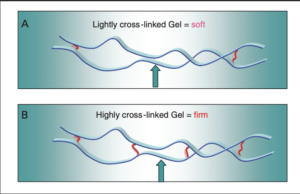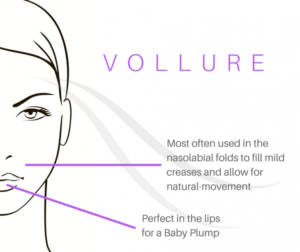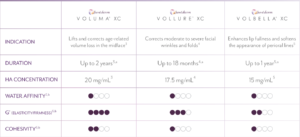Hyaluronic Acid fillers are comprised of cross-linked chains of hyaluronic acid molecules. The main difference between the different types of fillers are the molecular weights and the degree of cross linkage between the hyaluronic acid chains.

Hyaluronic Acid Polymers chains can vary greatly in their length (measured by molecular weight) and these chains are cross-linked to form gels which are what comprise the Hyaluronic Fillers that are injected into your face. The degree of cross- linking and the chain length influence characteristics of the filler. G Prime (G’) refers to the stiffness/elasticity of the filler and its ability to add lift. Generally speaking fillers with a higher G’ will be firmer and be able to add more lift which fillers with a lower G’ will be softer and will be more suitable to treating delicate areas.
However, this probably doesn’t mean much to you. What you really want to know which filler is best for each area of the face and which filler is least likely to migrate. In this post I interviewed one of best Aesthetic Injectors in Toronto to bring you a super detailed guide between the differences among the most common dermal fillers!
But first, here is a list of the most popular Juvéderm and Restylane Filler Products and the Hyaluronic Acid concentration per mL in each of the fillers.
Juvéderm:
- VOLBELLA- 15mg/ml.
- VOLLURE- 17.5mg/ml
- VOLUMA- 20mg/ml
- ULTRA XC- 24mg/ml
- ULTRA PLUS XC- 24mg/ml;
Restylane:
- Restylane L: 20mg/ml
- Lyft: 20mg/ml
- Kysse: 20mg/ml
- Refine: 20mg/ml
- Define: 20mg/ml
I went IN-DEPTH in an interview with one of the Best Cosmetic Injectors in Toronto, Emily Varga, RN, BScN, about the differences between various filler brands.
I’m impressed with her work in general but her work especially with the lips is fabulous! She’s definitely one of the best when it comes to filling the lips in a beautiful aesthetic shape while preventing migration to the philtrum as is so common in the plastic surgery industry.
We discussed everything from which is her favourite brand of filler, which fillers are most and least likely to migrate, which fillers produce the most natural results, and much more!
Many thanks to Emily for being such a great interview!
To see more of her work check out her out on IG or go to her website: https://emilyvarga.ca/
What Are The Main Differences Between Juvéderm and Restylane?
The main clinical differences in these products lie mostly in the consistency, degree to which they spread, and longevity. Juvederm tends to be smoother and therefore more susceptible to spreading out. In some cases, this may be advantageous, but migration in certain areas may produce undesirable effects. This spreadable nature of the product makes it less likely to cause lumps than Restylane and other dermal fillers.
Comparatively, Restylane tends to be more granular and generally remains where it was injected. This makes it ideal for fine and controlled injections such as the lips or scars/wrinkles, where you prefer no migration or diffusion.
Which is less Likely to migrate, Juvederm or Restylane?
Restylane is less likely to migrate than Juvederm from my experience. This is due to it’s more granular nature which means it spreads less once injected into the skin. This can be beneficial when injected certain areas like the lips but more spreadability may be desired when working with other areas.
Juvederm is said to last 1-2 years, however, I have many patients with remaining filler even after 4-6+ years, nearly all of them experience some degree of migration. Restylane generally lasts 6-18 months for the average person.
Despite the differences in the fillers, many of the complications we see with Juvederm and Restylane are often not caused by the product itself but are likely due to the wrong selection within the product line for the target area and/or injection depth.
-Emily Varga, RN, BScN
Is there a Significant Difference Between Injecting different products from various filler brands? For example, would injecting Juvederm Volbella and Voluma provide a Noticeably different result?
Absolutely you can expect different results from different products within various filler brands, that is their purpose. As an injector, there are a few key qualities of filler that we consider when selecting a product to treat a specific concern, known as its rheology. These components include: concentration and size of HA molecule, elasticity, viscosity, and cross-linking. These product mechanics come together to define how well a filler can be adapted to a tissue and influence its bio-integration.
Have you noticed a difference between the difficulty of dissolving products from Restylane and Juvederm?
When it comes to dissolving, I do not notice a difference and both respond well to hyaluronidase treatment in the average person. The only instances where the product may make some difference when doing corrections is in the case of lumps and encapsulation. Restylane seems to cause lumps more often, likely due to less spreadability on injection. I believe that these side effects can be largely mitigated by the injector and patient after-care.
-Emily Varga, RN, BScN
How does Stylage compare to Juvederm and Restylane? Can you also go into detail about the Stylage equivalent to the other brands for the lips and how it compares?
-Emily Varga, RN, BScN
What are your Favourite Stylage Products for the lips, chin, cheeks, and facial Folds
Picking a favourite or preferred product is difficult, the entire range has different applications and all are amazing! I always use Stylage S or M for the lips, depending on what the goal is and what the client is starting with. S is also great for superficial treatment of lines and wrinkles, undereyes or scars. M works well for shadowing or “glazing” as I like to call it. Stylage L is reserved for chins, jaws and cheeks and when a little extra volume is needed or for more structure, XXL is the preferred choice! I am very excited for their products that they’re optimizing for Canadian markets such as HydroMax and SpecialLips– more on that as it comes!
-Emily Varga, RN, BScN
Does the Brand and Type of Filler used make a Large Difference on the appearence and size/volume added to the injected area?
For ex, would using 2ml of Volbella vs Vollure achieve a Different size/appearence the lips?
Within filler brands, the product selection makes a huge difference on the appearance of the injected area. It is your injector’s job to understand the indication for each product and how it behaves in the tissues. For example, 2ml of Stylage S looks dramatically different than 2ml of Stylage XXL, the latter being much more noticeable and volumizing. The same concept exists across different brands with comparable products, though usually more subtly– Ex. Juvederm Voluma vs. Stylage L are comparable, yet different in their behaviour in the tissue.
-Emily Varga, RN, BScN
I was wondering if you’ve seen the post by Dr. Ben Talei pleading his patients to not get Voluma in the under-eyes and I was wondering what your thoughts were about this.
Any injector willing to put Voluma in under eyes should be called to question – this product is intended for cheeks, chin or jawline, NOT the delicate undereye area. Voluma was created to build volume: it is highly elastic, holds a lot of water and is quite thick. Not only does this product placed here provide an unsightly, puffy result, it also increases the risks associated with undereye filler injections. He is absolutely right to advise them never to use this product in this area! AH!
-Emily Varga, RN, BScN
Can you spot just from looking if someone's lips/cheeks/face have been injected with Juvederm, Stylage, Restylane, or a different brand of filler?
This is an interesting question- but yes, usually I can. I am also able to identify other injector’s work, merely through observation. There are many talented injectors whom each use different brands for their own reasons and then there are plenty of poor injectors using the same brands. This makes the distinction that not just the product, but the technique, skill, and style of the injector matter greatly in the outcome. This is why you should base your decision more so upon the injector’s expertise than the filler brand.
-Emily Varga, RN, BScN
What is the Best filler for the Nasolabial Folds while preserving a natural smile
When it comes to treating the nasolabial folds naturally, you want a flexible product with high elasticity. Thick products here result in thick looking or distorted animations when smiling.
I typically use Stylage S superficially in the skin and sometimes treat the pyriform aperture (by the nostrils) deep with Stylage L or XXL, when indicated. I see great injectors using Restylane in the same way. I prefer Stylage because I have had absolutely zero issues with lumps, tyndall effect (blueish discolouration of the skin) or more serious issues like necrosis. Their formulations, in my opinion and experience, are superior to other filler brands for this indication.
-Emily Varga, RN, BScN
What are some of the top picks of brand/kind of filler for adding cheek volume and shape?
Choosing the right filler for cheek volume and shaping is important. Diagnosing the issue and taking into respect the entire face proportion is even more so.
When the issue is mid-face volume loss, I typically opt for Stylage M , L or XXL, depending on the persons skin quality and BMI/Facial fat volume. Thinner products like M or L are more suitable for thinner skin and subtle corrections whereas thicker products like L and XXL are more suitable for thicker skin, and more aggressive volume correction.
I am selective of who I choose to “contour” as they must have a fairly low BMI to achieve their desired result, otherwise overfilling the face can result in someone looking “full” or “puffy”.
Contouring is best done with a thick, highly elastic product like L or XXL so that the product gives a pronounced look and also stays in place. Filler naturally absorbs water and settles flat, so massage techniques are also important to improve and sustain results.
-Emily Varga, RN, BScN
Which type of Filler is best to use for the Jawline form your experience?
Jawline is best treated with a dense product as we are trying to re-create the appearance of bone. There is minimal fat along the jawline so the right product and placement in this area is key. I usually use XXL or L depending on the client’s goals and starting point.
-Emily Varga, RN, BScN
If you have leftover filler from injecting the lips would it be ok to use that for the chin/vice versa?
After filling the lips, leftover product may absolutely be used elsewhere, why waste it (unless it’s completely unnecessary or unwanted).
Thinner products, like Stylage S, may be used in shadowing, wrinkles, nasolabial folds, undereyes/troughs, or the chin in some cases.
Medium thickness products like Stylage M can be use for wrinkles, nasolabial folds, nose tip, temples or the chin. I always have a conversation with the client to see if they have any concerns or may suggest a good use for remaining filler.
Something I always pay attention to is the proportion of the lips to the nose and chin– often when we bring the lips out with more volume, a small bit in the chin harmonizes proportions to create a delicate and balanced profile.
-Emily Varga, RN, BScN
If You Have Some Of The Thicker Filler, Such As Voluma From Using In The Cheeks, Would You Recommend Against Using It For The Lips?
Although its rare to not use a full syringe when treating one of these areas, any remnants of cheek/jaw/chin filler may be used elsewhere but almost never in the lips as it’s too thick and can create an unnatural looking result.
Thicker products are not meant to be at superficial depths as it may compromise the health of the tissues. They are specifically formulated for deeper tissues and should only be used where appropriate. I like to tell my clients, you are paying for the procedure, not the ml, so discarding remaining product is completely fine and recommended if it has no beneficial use elsewhere. Honesty here is key!
-Emily Varga, RN, BScN
What is More Important for Preventing Migration of Filler (for ex into the philtrum), Spreading the Injections Over Multiple Sessions or the Brand/Type of Filler Used?
It is hard to say which matters more, I wouldn’t say that they are mutually exclusive. If you fill a lip with a gradual approach using the wrong filler, you aren’t going to achieve a natural result. The same goes for the reverse; treating quickly with the right product doesn’t allow time for the lip to accommodate the change in volume again resulting in a sub-optimal result. Both of these matter equally in creating natural looking and feeling lips that last.
-Emily Varga, RN, BScN
Which filler brand/type do you recommend for use in the Under-Eye area while maintaining a natural look
For the undereyes, I prefer Stylage S injected with cannula technique for enhanced safety, accurate depth and consistency of injection. This product is smooth and spreadable which reduces risk of lumps and bumps.
I know many injectors who love Belotero for this area. Less is more here, and candidate selection is the most important. If you consistently experience puffy eyes, have bags or festoons, severe creepiness or skin laxity you may not be a good candidate. Undereyes are something you want to get right the first time as dissolving in this area is tricky and the delicate skin must be considered. Sometimes cheek support sufficiently corrects the undereyes as well or is used as a support scaffold for trough filler. Careful assessment is paramount to achieve the perfect correction.
Have you seen the Video by Victorian Cosmetic Institute explaining why they don't believe in Filling Faces anymore due to the Filler never really Dissolving and just Migrating and if you have what are your thoughts about this?
-Emily Varga, RN, BScN






